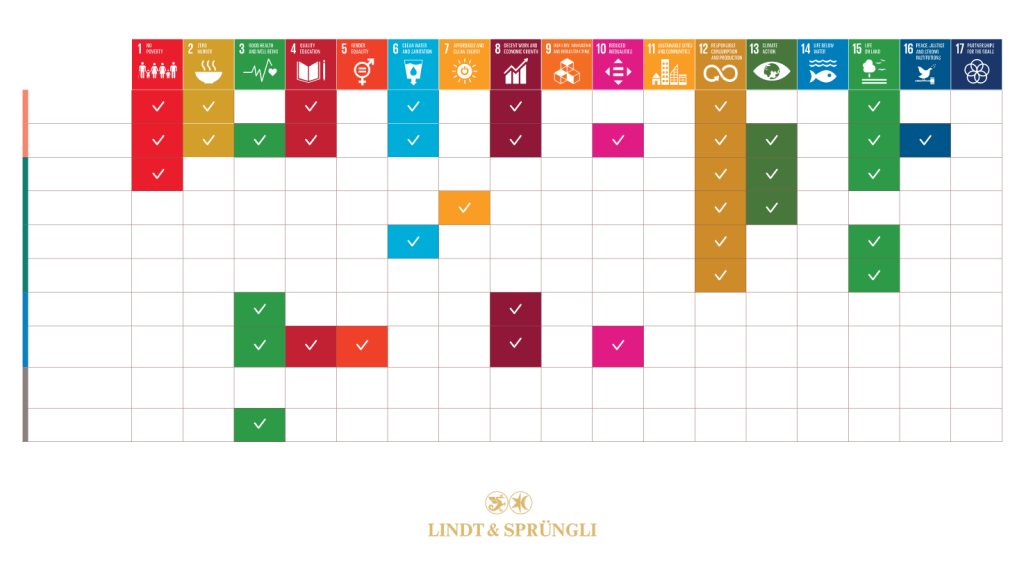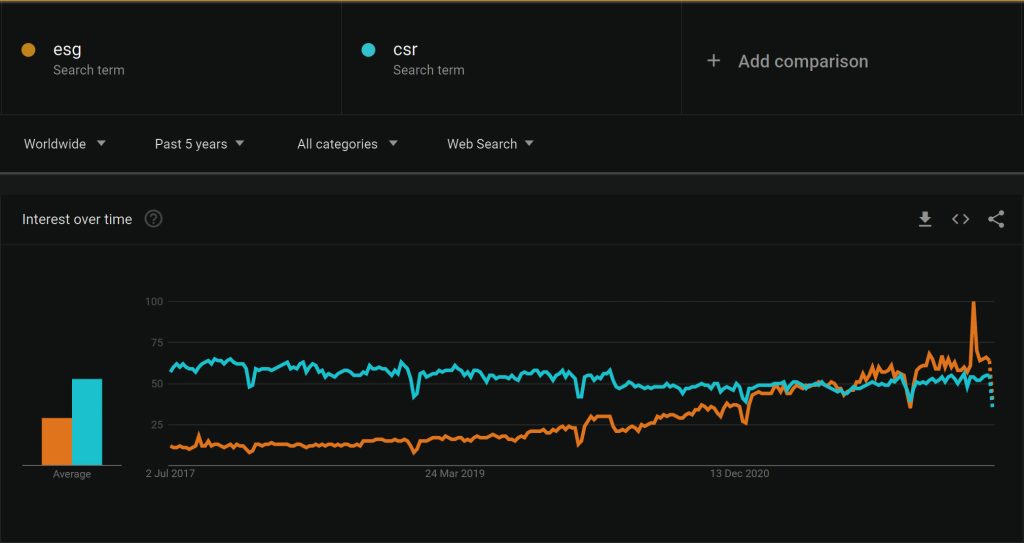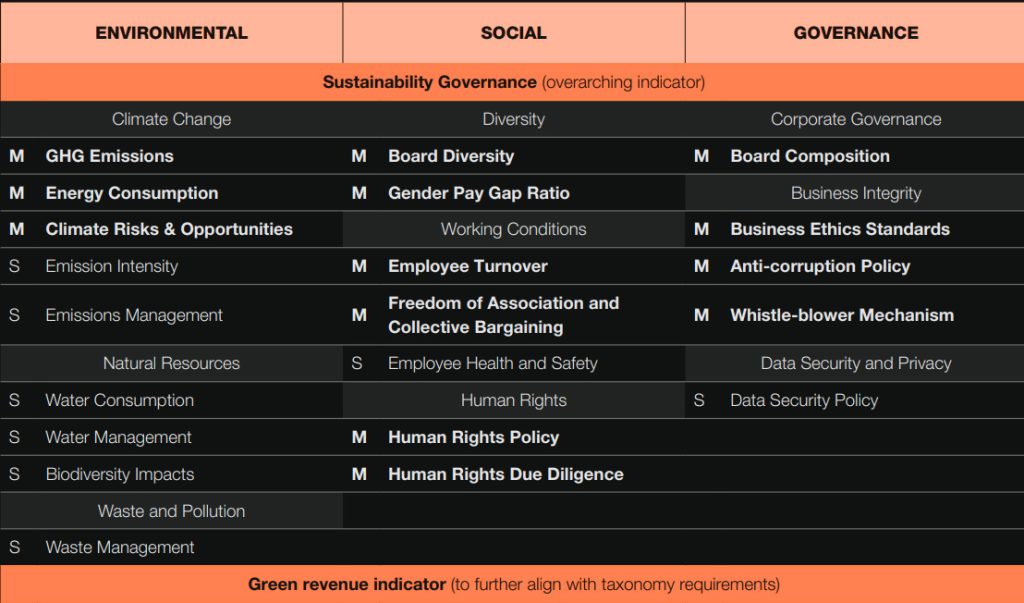
By Wojciech Bąk
While in conversation with clients from different countries about topics related to the aspects of sustainable development, I was often not sure if we were talking about the same thing. I’ve noticed that many of us use the terms ESG (Environmental, Social, Governance) and Sustainability interchangeably. Still, others use the words “environment” and “sustainability” synonymously, most likely considering sustainable development as one of the three pillars of ESG. Once you add additional topics to the conversation, such as SDGs (Sustainable Development Goals) and CSR (Corporate Social Responsibility), it becomes very easy to get truly confused. This inspired me to tackle this topic, as a good understanding of these terms significantly impacts creating better corporate strategy, improving communication, sorting priorities, and making reporting that much easier. So how to find yourself in all this, understand the interrelationships and analyze the right indicators?
Where to start?
Let’s say frankly that the division is only arbitrary and there is no only correct definition of these concepts – the boundaries between them are fluid. Personally, I think that it is more important to understand the meaning and purpose of these concepts than to fight over individual phrases and words. This does not prevent us from trying to organize the terminological area around sustainable development so that we are having our conversations with customers, partners, and employees on the common ground. Let’s try it then!
Sustainable Development
The concept of sustainability originates from the idea of sustainable development and it is widely used in the corporate context. I understand sustainability as a set of factors through which a company generates an impact on the sustainable development of our planet. For better clarity, I refer here to one globally recognized UN definition of sustainable development. Accordingly, sustainable development is about securing the needs of currently living people while not being detrimental to meeting the needs of the generations to come. It means reducing consumption, developing environmentally-friendly technologies, or discovering new ways of satisfying demands. However, the way we understand it should go beyond ecology and the environment. Sustainable development requires putting common effort into building a balanced and resilient future for both all the people in the world and the planet itself. It can be done only by integrating taking care of the environment with social justice, as well as the harmonious development of the economy, education, and innovation.
Looking from the business perspective, sustainability has recently become the synonym for “being green” or “carbon footprint reduction”. While thinking about sustainability, we mostly consider such ventures as lowering energy use or reducing water consumption. There is nothing wrong with emphasizing those things, as they are important goals for any organization that wants to lower costs, improve effectiveness and make a positive impact. However, these are not exhaustive in the context of sustainability, which includes all the efforts of the company that aims to lower its impact on its environment. It could also mean creating new job opportunities or promoting gender equality apart from helping protect nature.
SDGs
Sustainable Development Goals have been adopted by the UN in 2015 to bring the idea of sustainable development to life. Together, the 17 SDGs aim at eliminating poverty, protecting our planet, and securing the peace and well-being of all people by the end of 2030.

Sustainable Development Goals defined by the UN
What does that mean in practice for business? Companies, to contribute to sustainable development, define their sustainability strategies based on the 17 goals and map their ventures to a specific goal. That way, an organization ensures that it addresses the current challenges of sustainable development.

Example of corporate development initiative mapping for sustainable development goals (Lindt & Sprüngli Sustainability Report 2021)
CSR
Corporate Social Responsibility is a management strategy that sets companies for voluntarily engaging with social interests, environmental aspects, and relations with different stakeholders, including employees.
Organizations executing CSR strategies are open and get involved in dialogue with stakeholders. While turning a profit is still important, there is just as much effort put into maintaining good relations with clients, employees, local communities, and shareholders. It is the positive impact on society that is the most distinguishing feature of CSR, where the company becomes a defining subject of its environment and a patron of the local market. It is a win-win situation for everybody involved.
ESG
ESG is a much more defined term, based on many regulations and using data from inside and outside the organization. It focuses on three aspects: environment, social, and governance. It is those very aspects that a company should focus on if it is aiming to gain clients and investors. ESG approach is becoming to have a more and more important role in corporate management. It is portrayed best by the fact that many companies depend on the ESG goal completion when awarding bonuses to the board. It is then crucial that the criteria are measurable and comparable.
ESG is currently a vital factor while making business decisions and it has a critical impact on the company’s value, investment decisions, or even the interest on bank loans. Usually rating agencies, such as S&P, rate ESG scores as point values based on specific data and reports. In that way, though similar to CSR, ESG is much more measurable and based on a specific framework. ESG’s growth in popularity at the expense of CSR can be observed particularly in the last 2 years, according to Google searching trends.

Comparison of search popularity between ESG and CSR (Google Trends)
What is the difference between CSR, ESG, and Sustainability then?
Though sustainability, CSR, and ESG have common interests, we shouldn’t use them synonymously, in my opinion. Sustainability is the way companies contribute to the implementation of the idea of sustainable development. Thus, sustainability can be considered a philosophy of doing business. Therefore, measuring sustainability is challenging. Indeed, SDGs can help with this to some extent. However, SDGs are a political initiative primarily aimed at governments and regulators. Companies can contribute, but are not responsible, for example, for peace, the rule of law, and strengthening institutions.
However, CSR is one of the areas of strategic management resulting from recognizing the responsibility of the organization for its impact on society and the environment. The initiatives taken are usually selective and difficult to verify against the criteria of sustainable development. In the case of CSR, companies are willingly evaluating the effectiveness of their actions. The emphasis is put on implementing initiatives, not measuring their results.
In opposition to CSR, ESG delivers a comprehensive framework for addressing sustainability issues. It focuses on how a given initiative can be assessed and quantified. Using many different scoring ratings, companies can legitimately evaluate their condition and present their ways of managing the supply chain, carbon footprint, or corporate governance to investors and clients. Implementing ESG shows the maturity of the business processes and the willingness to more precise monitoring of its impact. For me, ESG is not a synonym, but a measure of sustainability.
What to analyze and report?
Given how sustainable development factors are directly connected to business advantages (better public image, client loyalty, and the value of investment), the ESG criteria have become a strong indicator of the company’s general condition. Because it is now common that clients, shareholders, and investors are looking into a given company’s sustainability aspect, it is no longer optional to keep a verifiable record on that matter. It is now a business “obligation”. Implementing common measures and measurement structures allows for the additional assessment of various enterprises on a similar level, which facilitates the improvement of the effectiveness of activities and adaptation to the highest market standards.

Recommended ESG metrics (ESG Reporting Guidelines, GPW 2021)
ESG is particularly close to me because it is based on real data, and the prospect of regular tracking, measurement, and comparison of units within the organization. In this aspect, ESG makes sustainable development an important element of building a culture based on facts and data (data-driven culture) where BI competencies become an inseparable element of sustainability.
Read more about sustainability:
Energizing ESG with Open Data and Power BI
Data-driven solutions for compliance in sustainability
ESG Reporting – Why is it so important to companies?
Microsoft sustainability reporting – how to work with Microsoft Cloud for Sustainability
